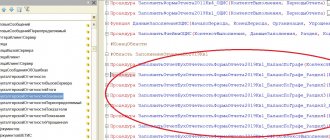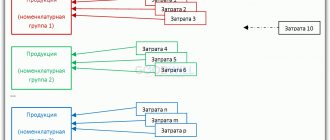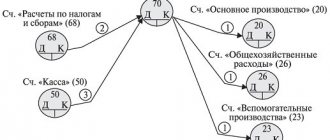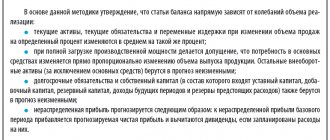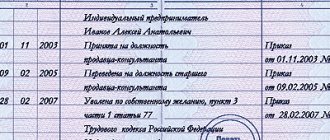Which accounts are closed at the end of the year?
Before starting to prepare the annual financial statements, that is, before reforming the balance sheet, the accountant is required to generate the final entries for the reporting period. In accounting, the reporting period is a calendar month (clause 48 of PBU 4/99). Consequently, before closing the financial year, the accountant will need to draw up the final monthly turnover.
Which accounts are closed at the end of the month or year? Such BSCh can be tentatively divided into three groups:
- Cash balances that cannot have balances at the end of the reporting (financial) period. These include counting. 25 “General production expenses” and 26 “General operating expenses”.
- BSCs that may have a remainder, but which can be completely closed. These include counting. 20 “Main production”, 23 “Auxiliary production”, 29 “Service facilities and production”.
- BSCs that cannot have a general balance, but have a balance in open subaccounts. These are 90 “Sales” and 91 “Other income and expenses”.
Next, we will look at how accounts are closed at the end of the year; the entries are also suitable for generating final entries at the end of the month. We will determine the procedure for generating final accounting entries separately for each account, which directly affect the financial results of the company.
The sequence of closing accounts and the factors that determine it.
Closing accounts is the final stage of accounting work for the reporting period, no less important than current accounting during the year. Closing an account means that the turnover on it is transferred to other accounts and the account does not have a balance. To obtain the final balance, the operating, collection and distribution and financial results accounts are completely closed: 23 “Auxiliary production”, 25 “General production expenses”, 26 “General business expenses”, 28 “Defects in production”, 29 “Service production and facilities”, 44 “Sales expenses”, 90 “Sales”, 91 “Other income and expenses”, 99 “Profits and losses”. Also, before drawing up the final balance sheet, the accounts for completed production are closed: 20 “Main production”, 97 “Future expenses”, 08 “Investments in non-current assets”.
In agricultural production, it is very important to correctly determine and economically justify the sequence of closing accounts. The conditions of agricultural production are such that the enterprise uses some of the products for its production needs. Ancillary industries also provide mutual services to each other. This creates certain difficulties when closing accounts. It is not always possible to completely distribute costing differences across the entire volume of products or work performed, since the closed account does not include costing differences from those accounts that are closed later. Consequently, in the accounts that are closed first, some of the costs remain without adjustment, that is, in the planned estimate. At the same time, the calculation difference on accounts that are closed last is not distributed to all accounting objects, since it is not possible to attribute the calculation difference to already closed accounts. It follows that when closing accounts, certain conventions are allowed, the largest number of which are allowed for accounts that are closed first.
In order to achieve a minimum of conventions when closing accounts, you must be guided by the following rule: first of all, the accounts of industries and industries that have the maximum number of consumers and receive a minimum number of counter services are closed, and last of all, accounts with a maximum of counter services and a minimum of consumers are closed. This principle should also be followed when closing analytical accounts within each synthetic account.
According to this rule, accounts are closed in the following sequence:
1) Assign the shop expenses of the repair shop to their intended purpose, calculate the cost of services of auxiliary production and close account 23 “Auxiliary production”.
2) Distribute deferred expenses, general production and general business expenses and close accounts 97 “Future expenses” (in terms of costs attributable to current year expenses), 25 “General production expenses”, 26 “General business expenses”.
3) Distribute or adjust the amounts of depreciation and repair costs of fixed assets recorded in separate accounts in the crop production industry.
4) Calculate the cost of production of the main industries and write off any identified deviations. In a certain sequence, sub-accounts are closed as part of account 20 “Main production”, account 28 “Defects in production”.
5) Close account 29 “Servicing industries and farms”.
6) Write off the costs of completed processes and clarify the entries in the accounts of the area of capital investments.
7) Determine financial results from the sale of products, works, services and close accounts 90 “Sales”, 91 “Other income and expenses”.
 Write off the profit or loss and close account 99 “Profit and Loss”.
Write off the profit or loss and close account 99 “Profit and Loss”.
We write off general production costs
The BSC is closed monthly, and all accumulated overhead costs must be written off to the accounts of the relevant production facilities. In other words, costs are written off to the accounts of those production facilities that were serviced.
Typical accounting entries:
| Operation | Debit | Credit |
| ODA written off in favor of core production | 20 | 25 |
| ODA included in the costs of servicing auxiliary production facilities and workshops | 23 | 25 |
| ODA aimed at maintaining service farms is written off to the appropriate accounts | 29 | 25 |
Write-off of general business expenses
The procedure for concluding an account. 26 depends on the method of forming the cost of finished products (sold services, work), which must be enshrined in the accounting policy of an economic entity. So, there are two key ways:
- At full production cost, the following standard transactions are generated monthly:
| Operation | Debit | Credit |
| OCR written off for main production | 20 | 26 |
| OCR included in the costs of auxiliary production | 23 | |
| OCR written off to service farms | 29 |
- According to the reduced production cost, all general operating costs are charged directly to the operating cost of sales. In this case, a monthly accounting entry is generated:
| Operation | Debit | Credit |
| OCR written off as the cost of products, works, services | 90-2 “Cost of sales” | 26 |
Closing production accounts
Let's make a reservation right away that the balance for BSC 20, 23, 29 is unfinished and does not require mandatory write-off at the end of the reporting or financial periods.
How to determine? If the production cycle does not coincide with the reporting periods, then a debit balance is formed on the BSC - the cost of work in progress. And if the production process fits into a calendar month (year), then, according to the BSC, there should be no leftovers. Typical entries for writing off production costs:
| Operation | Debit | Credit |
| Production costs written off to cost of sales | 90-2 “Cost of sales” | 20 |
| 23 | ||
| 29 |
Note that companies whose activities are related to the provision of services can additionally establish in their accounting policies which accounts are closed at the close of the month. In other words, to secure that BSCs 20, 23, 29 will be closed monthly, without any work in progress balances.
Closing the account at the end of the period
The determination of the financial result of the company’s activities is carried out not only before the reformation of the balance sheet, but also at the end of the reporting period - the calendar month. In this article we will tell you which accounts are closed at the end of the reporting month and calendar year.
First of all, let's define the concept. Thus, in accounting, account closure (ACC) is recognized as an accounting operation of attributing the final balance of the accounting account to special CACs, which determine the financial results of the company.
We close accounting account 90 “Sales”
At the end of the reporting month, the company is obliged to determine the financial result of its activities. This operation is a comparison of subaccounts. 90. That is, the accountant compares the indicators of subaccount 90-1 “Revenue” and the value of cost of sales, which is defined as the sum of subaccounts 90-2 “Cost”, 90-3 “VAT”, 90-4 “Excise taxes”, 90-5 “Trade and export duties."
If the company made a profit (revenue exceeded total costs), then the accountant generates the following entry:
Dt 90-9 Kt 99 - profit from sales is reflected.
If the company operates at a loss (revenue is lower than total costs), then the following entry is recorded:
Dt 99 Kt 90-9 - reflects the monthly loss for the company’s activities.
Consequently, subaccounts. 90 may have a balance at the end of the reporting month, but the total value of the synthetic BSC must be equal to zero.
Which accounts are closed at the close of the year? The following accounting entries are generated for this account at the end of the year:
| Operation | Debit | Credit |
| The “Revenue” sub-account was closed at the end of the year | 90-1 | 90-9 |
| The cost of production is included in the financial result | 90-9 | 90-2 |
| VAT is written off in favor of profits and losses | 90-9 | 90-3 |
| Excise taxes are included in the financial results of operations | 90-9 | 90-4 |
| Export trade duties written off at the end of the year | 90-9 | 90-5 |
We close account 91 “Other income and expenses”
The company must determine monthly financial results based on income and expenses from other activities. This financial result is determined as the difference between the subaccounts of the account. 91. That is, we compare 91-1 “Other income” with 91-2 “Other expenses”.
The results of activities are reflected in the following accounting entries:
| Operation | Debit | Credit |
| Profit at the end of the month from other types of company activities is reflected | 91-9 | 99 |
| Reflected loss from other activities | 99 | 91-9 |
At the end of the financial year, the accountant makes the following entries:
| Operation | Debit | Credit |
| Profit for the year from other types of company activities was written off | 91-1 | 91-9 |
| Reflected loss from other activities for the year | 91-9 | 91-2 |
In turn, count. 99 “Profit and Loss” remains unclosed. This BSCH closes on December 31st. The accountant generates the following entries:
- Dt 99 Kt 84—– reflects the net profit of the reporting year;
- Dt 84 Kt 99 - the company's uncovered loss is reflected.
Closing the year in the 1C: Enterprise Accounting program 8 ed. 3.0
The reporting period for the preparation of annual accounting (financial) statements is a calendar year - from January 1 to December 31 inclusive, except in cases of creation, reorganization and liquidation of an organization. The year has ended, which means it’s time for the accountant to sum up the work for the year, including reforming the balance sheet and drawing up annual accounting (financial) statements. In this article we will look at how to close the year and reform the balance sheet in the 1C: Enterprise Accounting program, 8th edition. 3.0.
What is balance sheet reformation? This is the last entry in December of the reporting year, which determines net profit or loss. This entry is made with the date of December 31, after all transactions of financial and economic activities are reflected in the accounting records. The balance sheet reform consists of two stages:
- closing financial results accounts 90 “Sales” and 91 “Other income and expenses”;
- reflecting net profit or loss as part of retained earnings or uncovered loss.
Any commercial organization is created solely for profit. Before moving on to closing the year, you need to make sure that the 1C program is updated to the latest release. Also in the program, all documents and all financial and economic transactions must be reflected in the accounting accounts. To do this, before preparing annual reports, it is necessary to conduct an inventory.
Let's move on to preparing the annual report. How to close a year in the 1C: Enterprise Accounting program 8 ed. 3.0? To do this, you need to select “Month Closing” in the “Operations” section. The month must be set to “December”. Next, click the “Close the month” button to close the month. The program will consistently perform all operations and complete the closing of the reporting year with “Balance Sheet Reformation” (Fig. 1).
Let's take a step-by-step look at closing the reporting period.
- We close account 90. Account 90 “Sales” is used to summarize information about income and expenses associated with the organization’s normal activities, as well as to determine the financial result for them. As a rule, the following subaccounts are opened for account 90 “Sales”:
- 90-1 “Revenue”;
- 90-2 “Cost of sales”;
- 90-3 “Value added tax”;
- 90-9 “Profit/loss from sales.”
Synthetic account 90 (collapsed) is closed monthly and has no balance at the end of the month. But throughout the year, debit or credit balances accumulate in subaccounts to account 90, depending on the type of subaccount. So, if revenue is reflected, for example, in the accounting entry “D62 K90-1”, then a credit balance accumulates in subaccount 90-1 during the year. And due to the fact that the cost of sales is written off, for example, by posting “D90-2 K43”, subaccount 90-2 has a debit balance on each reporting date during the year.
It is on December 31 that subaccounts to account 90 are closed: subaccounts 90-2, 90-3, etc. are closed to subaccount 90-9. For example, subaccount 90-2 at the end of the year will be closed like this: “Debit subaccount 90-9 – Credit subaccount 90-2.”
After all debit balances of subaccounts to account 90 are written off to subaccount 90-9, it is necessary to close subaccount 90-1 on subaccount 90-9: “Debit of subaccount 90-1 – Credit of subaccount 90-9.”
This accounting entry simultaneously resets subaccounts 90-1 and 90-9 (Fig. 2).
To determine the financial result, it is necessary to reflect the following entries: Dt 90.09 “Profit (loss) from sales” Kt 99 – 7,913.59 rubles. = (20,380 revenue (subaccount 90.01) – 3,108.31 VAT (subaccount 90.03) – 9,357.60 cost (subaccount 90.02). In this case, profit was generated. If the amount of expenses reflected in account 90.02 in December would increase turnover for December on account 90.01, in this case the organization would have gone to a loss. Accordingly, the posting would have been different: “Dt 99 Kt 90.09” for the amount of loss from sales (Fig. 3).
- We close account 91. Account 91 “Other income and expenses” is used to summarize information about other income and expenses of the reporting period. The following subaccounts are usually opened for account 91 “Other income and expenses”:
- 91-1 “Other income”;
- 91-2 “Other expenses”;
- 91-9 “Balance of other income and expenses.”
As in account 90, on account 91, in the credit of subaccount 91-1, a credit balance of income accumulates throughout the year, and in the debit of subaccount 91-2, a debit balance of expenses. Subaccount 91-9 may contain both a credit and a debit balance, depending on whether there were more profits or losses during the year. With all this, synthetic account 91, like account 90, is closed at the end of each month and has no balance.
At the end of the year, the debit balances of the subaccounts of account 91 are written off to subaccount 91-9: “Debit of subaccount 91-9 – Credit of subaccount 91-2,” and then subaccount 91-1, by analogy with subaccounts to account 90, is closed at 91-9: “Debit of subaccount 91-1 – Credit of subaccount 91-9.”
- We close account 99. Account 99 “Profits and losses” is used to summarize information on the formation of the final financial result of the organization’s activities in the reporting year. Account 99 “Profits and losses”, where profits and losses from ordinary activities and other operations are written off monthly during the year, is also subject to closure at the end of the year. Profit reformation is when, by the final entry of December, account 99 is closed to account 84 “Retained earnings (uncovered loss)” and thereby reset to zero.
If the total profit for all types of activities at the end of the year is: “Debit of account 99 – Credit of account 84.” If the year ended with a loss: “Debit account 84 – credit account 99.”
If the organization made a profit at the end of the year, it is necessary to distribute the net profit in the program. The distribution of profits is made in the next (after the reporting year) year based on the decision of the founders of the organization. For example, they can use it for dividends, for creating reserve funds, for increasing the authorized capital, and also for covering losses of previous years. In “1C: Accounting 8”, the specified operations are reflected in the “Operation” document (section “Operations” - “Operations entered manually”):
- “Debit 84.01 Credit 75.02” – accrual of dividends;
- “Debit 84.01 Credit 82.02” – transfer of funds to reserve funds;
- “Debit 84.01 Credit 80.09” – increase in authorized capital;
- “Debit 84.01 Credit 84.02” – covering losses from previous years.
After reflecting these transactions, the balance of subaccount 84.01 should be transferred to the credit of subaccount 84.03 “Retained earnings in circulation”: “Debit 84.01 Credit 84.03” - a reflection of the balance of retained earnings.
Subaccount 84.03 accumulates the total amount of profit not distributed among shareholders (participants).
To check the correctness of completed year-end closing transactions, you can use the “Turnover balance sheet” report. Having generated it in the “Reports” section – “Turnover balance sheet”. After the reformation of the balance sheet, as of December 31 of the reporting year, the balance in accounts 90, 91 and 99 is zero (Fig. 4).
Dear readers, in this article we told you about the main points that you need to consider when closing the year. We wish you successful submission of the annual report!
